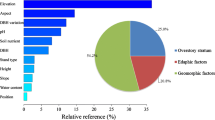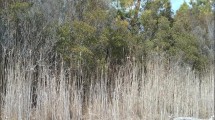Abstract
Increasing land salinization in Australia is predicted to lead to severe declines in species diversity in affected areas, and perhaps significant numbers of species extinctions. Much of the diversity that will be lost consists of understorey and mid-storey species, yet the overwhelming majority of research has focussed on salinity tolerance in tree species. We investigated how the presence of a shallow, saline water table affected the understorey species composition, species richness and species diversity in two remnant Eucalyptus wandoo Blakely woodlands in the Western Australian wheatbelt. Species richness and species diversity were significantly lower in areas with a shallow water table at elevations < 0.5 m above the lowest local elevation, compared with both higher elevations and with areas of low elevation without a shallow water table. Species composition (Bray-Curtis similarities) was also significantly different in low elevation, saline areas. At one site, saline areas were colonized by native and alien species that were not present in the surrounding vegetation, yet the community that has developed does not contain either the species or structural diversity of the surrounding system. At the other site, no colonisation of saline areas by new species occurred. Even though small differences in elevation (< 0.5 m) at our study sites were important in moderating the impacts of salinity in areas with a shallow water table, the loss of species diversity, species richness and structural complexity in low-lying elevations indicated that the ecological risk from secondary salinity to species associated only with drainage lines, seasonally wet flats and other low-lying areas is severe. The priority is to identify those vegetation communities that are restricted to only low relative elevations within the landscape and that only occur in remnants predicted to be at a high risk of developing a shallow and saline water table.
Similar content being viewed by others
References
Allen J A, Pezeshki S R and Chambers J L 1996 Interaction of flooding and salinity stress on baldcypress (Taxodium distichum). Tree Physiol. 16: 307–313.
Barendregt A, Wassen M J and Schot P P 1995 Hydrological systems beyond a nature reserve, the major problem in wetland conservation of Naardermeer (The Netherlands). Biol. Conserv. 72: 393–395.
Beard J S 1983 Ecological control of the vegetation of southwestern Australia: moisture versus nutrients. In Kruger F J, Mitchell D T and Jarvis J U M (Eds) Mediterranean-Type Ecosystems. The Role of Nutrients, pp. 66–73. Springer-Verlag, Berlin.
Beard J S 1990 Plant Life of Western Australia. Kangaroo Press, Kenthurst. 310 p.
Bell D T 1999 Australian trees for the rehabilitation of waterlogged and salinity-damaged landscapes. Aust. J. Bot. 47: 697–716.
Bornman T G, Adams J B and Bate G C 2002 Freshwater requirements of a semi-arid supratidal and floodplain salt marsh. Estuaries 25: 1394–1405.
Callaway R M, Jones S, Ferren Jr W R and Anuja P 1990 Ecology of a mediterranean-climate estuarine wetland at Carpinteria, California: plant distributions and soil salinity in the upper marsh. Can. J. Bot. 68: 1139–1146.
Clarke K R and Gorley R N 2001 Primer v5: User Manual/Tutorial. Primer-E Ltd, Plymouth. 91 p.
Clarke K R and Warwick R M 2001 Change in Marine Communities: An Approach to Statistical Analysis and Interpretation. Primer-E Ltd, Plymouth Marine Laboratory, Plymouth.
Cramer V A and Hobbs R J 2002 Ecological consequences of altered hydrological regimes in fragmented ecosystems in southern Australia: Impacts and possible management responses. Austral Ecol. 27: 546–564.
Cramer V A, Hobbs R J, Hodgson G and Atkins L in press The influence of local elevation on soil properties and tree health in remnant eucalypt woodlands affected by secondary salinity. Plant Soil.
Ganade G 2001 Forest restoration in abandoned pastures of Central Amazonia. In Bierregaard Jr R O, Gascon C, Lovejoy T E and Mesquita R C G (Eds) Lessons from Amazonia. The Ecology and Conservation of a Fragmented Forest, pp. 314–324. Yale University Press, New Haven.
George R J 1992 Hydraulic properties of groundwater systems in the saprolite and sediments of the wheatbelt, Western Australia. J. Hydrol. 130: 251–278.
George R J, McFarlane D J and Speed R J 1995 The consequences of a changing hydrologic environment for native vegetation in southwestern Australia. In Saunders D A, Craig J L and Mattiske E M (Eds) Nature Conservation 4: The Role of Networks, pp. 9–22. Surrey Beatty & Sons, Chipping Norton.
Hewitt N and Kellman M 2002 Tree seed dispersal among forest fragments: II. Dispersal abilities and biogeographical controls. J. Biogeogr. 29: 351–363.
Hobbs R J, Groves R H, Hopper S D, Lambeck R J, Lamont B B, Lavorel S, Main A R, Majer J D and Saunders D A 1995 Function of biodiversity in the Mediterranean-type ecosystems of southwestern Australia. In Davis G W and Richardson D M (Eds) Mediterranean-Type Ecosystems. The Function of Biodiversity, pp. 233–284. Springer-Verlag, Berlin.
Honnay O, Verheyen K, Butaye J, Jacquemyn H, Bossuyt B and Hermy M 2002 Possible effects of habitat fragmentation and climate change on the range of forest plant species. Ecol. Lett. 5: 525–530.
Jansen A J M, Eysink F T W and Maas C 2001 Hydrological processes in a Cirsio-Molinietum fen meadow: Implications for restoration. Ecol. Eng. 17: 3–20.
Jolly I D, Walker G R, Hollingsworth I D, Eldridge S R, Thorburn P J, McEwan K L and Hatton T J 1996 The causes of decline in eucalypt communities and possible ameliorative approaches. In Walker G R, Jolly I D and Jarwal S D (Eds) Salt and Water Movement in the Chowilla Floodplain, pp. 119–150. CSIRO Division of Water Resources, Canberra.
Keighery G, Halse S and McKenzie N 2001 Why wheatbelt valleys are valuable and vulnerable: The ecology of wheatbelt valleys and threats to their survival. In Dealing with Salinity in Wheatbelt Valleys: Processes, Prospects and Practical Options. http://www.wrc.wa.gov.au/protect/Salinity/Papers.pdf
Lymbery A J, Doupé R G and Pettit N E 2003 Effects of salinisation on riparian plant communities in experimental catchments on the Collie River, Western Australia. Aust. J. Bot. 51: 667–672.
McFarlane D J, George R J and Farrington P 1993 Changes in the hydrologic cycle. In Hobbs R J and Saunders D A (Eds) Reintegrating Fragmented Landscapes: Towards Sustainable Production and Nature Conservation, pp. 46–189. Springer-Verlag, New York.
Mensforth L J and Walker G R 1996 Root dynamics of Melaleuca halmaturorum in response to fluctuating saline groundwater. Plant Soil 184: 75–84.
Myers N, Mittermeier R A, Mittermeier C G, da Fonseca G A B and Kent J 2000 Biodiversity hotspots for conservation priorities. Nature 403: 853–858.
National Land and Water Resources Audit 2001 Australian Dryland Salinity Assessment 2000. Extent, impacts, processes, monitoring and management options. Land and Water Australia, Canberra. 129 p.
Niknam S R and McComb J 2000 Salt tolerance screening of selected Australian woody species - A review. For. Ecol. Manage. 139: 1–19.
Noe G B and Zedler J B 2001 Variable rainfall limits the germination of upper intertidal marsh plants in southern California. Estuaries 24: 30–40.
Paczkowska G and Chapman A R 2000 The Western Australian Flora. A Descriptive Catalogue. Wildflower Society of Western Australia (Inc.), Western Australia Herbarium, CALM and Botanic Gardens and Park Authority,Perth. 652 p.
Peck A J and Williamson D R, Eds. 1987 Hydrology and salinity in the Collie River Basin, Western Australia. J. Hydrol., Special Ed. 94: 1–198.
Pennings S C and Callaway R M 1992 Salt marsh plant zonation: the relative importance of competition and physical factors. Ecology 73: 681–690.
Roy V, Bernier P-Y, Plamondon A P and Ruel J-C 1999 Effect of drainage and microtopography in forested wetlands on the microenvironment and growth of planted black spruce seedlings. Can. J. For. Res. 29: 563–574.
Ruprecht J K and Schofield N J 1989 Analysis of streamflow generation following deforestation in southwest Western Australia. J. Hydrol. 105: 1–17.
Williamson D R, Stokes R A and Ruprecht J K 1987 Response of input and output of water and chloride to clearing for agriculture. J. Hydrol. 94, 1–28.
Author information
Authors and Affiliations
Corresponding author
Rights and permissions
About this article
Cite this article
Cramer, V.A., Hobbs, R.J. & Atkins, L. The influence of local elevation on the effects of secondary salinity in remnant eucalypt woodlands: Changes in understorey communities. Plant Soil 265, 253–266 (2004). https://doi.org/10.1007/s11104-005-0361-5
Received:
Accepted:
Published:
Issue Date:
DOI: https://doi.org/10.1007/s11104-005-0361-5




